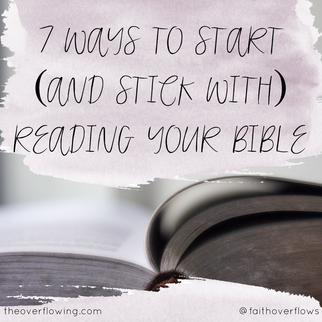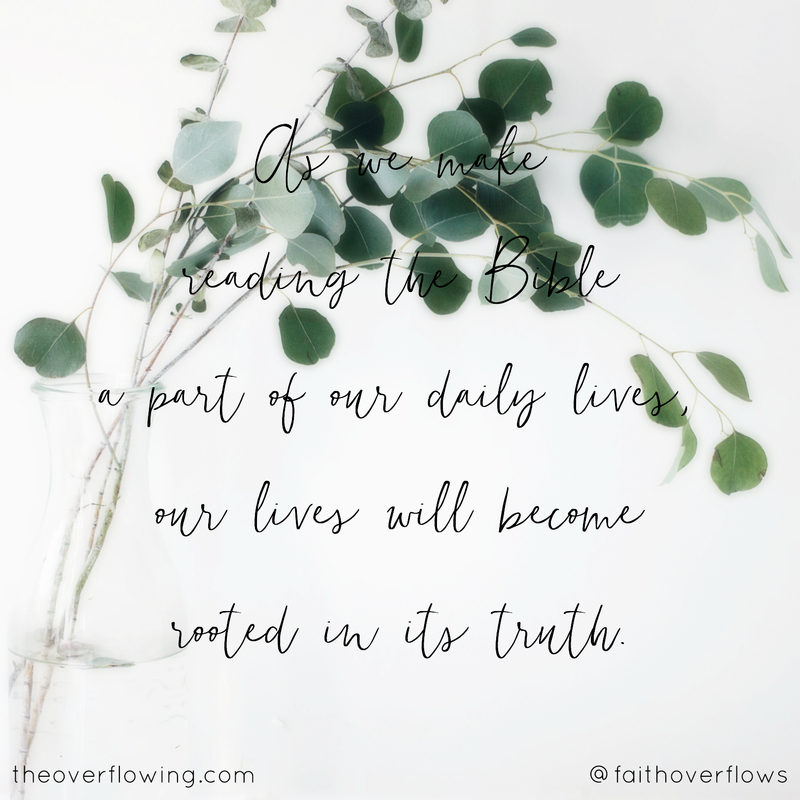|
When it comes to reading the Bible, getting ourselves started can be the hardest part. We’ve set aside time to spend in God’s Word… now, how do we actually spend that time in God’s Word? Where do I start? What should I read? How much should I read? When it comes to answering the questions of Where do I start? and What should I read? you’ll get different responses. But one answer I’ve heard given by many pastors and teachers, and the answer I often give when asked, is to start with one of the Gospels: Matthew, Mark, Luke, or John. The word gospel means “good news”. The Gospels are accounts of Jesus’ life, death and resurrection. God loving us so much that He would send His Son to die in our place so that we could be reconciled to Him, THAT is good news. The best kind of good news. So the Gospels are a great place to start. Now, you don’t have to start with a Gospel to start reading the Bible. The whole Bible is God’s Word, and He speaks to us from every page. Starting with the Gospels is what is recommended, because in reading them, you’ll become familiar with Jesus ministry and sacrifice on the cross. The Gospels are written more in story-form, detailing Jesus’ teachings and miracles and interactions with people, so that makes them a bit easier to read and understand than other books. But again, you don’t have to start with a Gospel. Maybe your church or small group is working through a different book of the Bible, and you’d like to read that during the week; then go for it! Now that you’ve picked what your going to read, it’s time to answer the question of How much do I read? Once again, you’ll get different responses. And I don’t think there is a right or wrong answer, so long as you’re actually spending time in God’s Word. According to Back to the Bible research, reading the Bible at least 4 times a week has great impact on one’s behavior and moral decisions. It is important to intentionally and regularly make time for being in God’s Word. As we make reading the Bible a part of our daily life, our life will become rooted in its truth. When it comes to how much to read in a sitting, go for quality over quantity. Whether reading one verse or one chapter, take time to let the words sink into your heart and meditate on them. Don’t simply read, listen. Let God speak. I know sometimes setting aside specific time to read our Bible can cause Bible reading to seem like a duty, rather than a desire. For the first while of reading as you get into the habit of being in God’s Word, it may feel like checking something off the to-do list. But if you desire to know Jesus and to serve Him, and to experience His love and power in your life, He will honor and fulfill that desire, and He will honor and use the time you spend in His Word. And you will soon find yourself looking forward to opening your Bible. Rather than being a chore, being in God’s Word will be a lifestyle. Below are some ideas (and resources) to help you with starting and continuing in reading your Bible. 
gotandem - when setting up the app you will fill out a Spiritual Profile, so the verses sent to you will be customized for you. Then you set the times you want to receive verses during the day. There are questions with each verse to ponder, and a spot where you can write notes. There are also Bible study tracks you subscribe to, and set the time you want to receive it. I’m currently doing the Worry to Wonder for Woman study, and loving it! first5 - first5 is designed to be your wake-up alarm. When you shut the alarm off, a short devotional comes up, so the first five minutes off your day are spent in the Word! Another cool thing about first5, is that they go through books of the Bible, and they have Experience Guides you can order if desired to use in studying the book, in correspondence with the morning devotionals. I’ve done the Leviticus and Hebrews Guide and it was A-MA-ZING! First5 is currently going through the books of Romans and 1&2 Corinthians. The next reading plan starts September 26 and goes through the book of Deuteronomy. She Reads Truth - use this app to read the Bible, and devotionals written by the SRT team. There are free and paid reading plans, including a free Bible-in-a-year plan. You can set the notifications to remind you to the read the Bible throughout the day. She Reads Truth also has study guides you can order if desired that correspond with the different reading plans. Currently SRT is going through the book of Hosea. The next reading plan starts on September 26 and goes through the books of First, Second and Third John.
The most important thing to remember when it comes to reading the Bible, is that it’s all about living in relationship with Jesus. When that is our purpose, desire and focus, He will speak to us from whatever book we are reading and in whatever amount of verses we read that day. I hope you’re encouraged to start getting into God’s Word, and to stick with it! I pray God reveals Himself to you through His Word, and I know He will. Let the words of Psalm 119:15-16 be our heart cry: I meditate on your precepts and consider your ways. I delight in your decrees; I will not neglect your word. This post is not endorsed by any of the products or resources mentioned in it, and I am not receiving any commission for recommending them. All opinions and beliefs stated are my own. The post Bible Study: Where (and how) do I start? first appeared on The Overflowing
1 Comment
|
|



